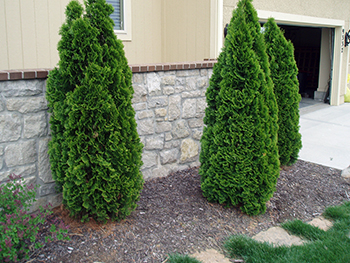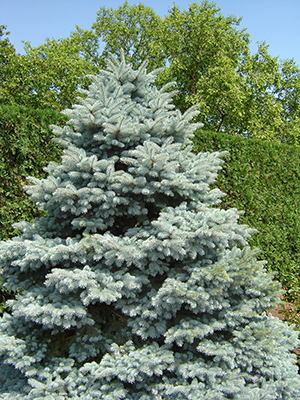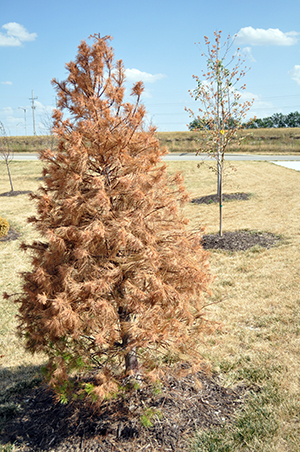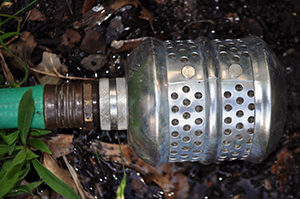Growing Evergreens in Kansas City
Return to Trees and Shrubs Agent Articles
Evergreens need attention when it comes to water  Evergreens are a staple in the landscape. They provide year-round interest and perform several functions in the landscape, from screening to simply making a visual impact. When I’m traveling around the country they seem to grow with ease. They dot the native woodlands and tower above other plants with little or no attention. Evergreens are much sought after in the Kansas City landscape but they can be a challenge to grow.
Evergreens are a staple in the landscape. They provide year-round interest and perform several functions in the landscape, from screening to simply making a visual impact. When I’m traveling around the country they seem to grow with ease. They dot the native woodlands and tower above other plants with little or no attention. Evergreens are much sought after in the Kansas City landscape but they can be a challenge to grow.
Evergreens, pines, spruce and other species all struggle to grow here. For Kansas residents we have the designation of being the only state in the union that does not have a native evergreen. Missourians, you are a little luckier as evergreens can be found in the wild in the southern part of the state, but not here in KC.
Secrets to successfully growing evergreens in Kansas City
In horticulture there is the old saying about growing any plant… right plant in the right place, planted and cared for in the right way. The devil is in the details and the application of that five letter word “right.” When it comes to plants, right means following the correct recommended care and maintenance practices for each particular plant. Let’s take a look at how the term "right" can be applied to achieving success with evergreens.
 Selecting the right evergreen for this area
Selecting the right evergreen for this area
First it starts with the right plant. The palate of evergreen choices for KC is limited.
- Pines have long been the standby evergreen. Pines can have insect and disease issues which limit the use of them in the landscape.
- As a whole spruce deserve a place in the landscape but their list of particular "rights" must be followed for long term success.
- Arborvitae, specifically ‘Green Giant’ has gained in popularity.
- The only other widely planted evergreen is junipers. Junipers are the only dependable evergreen in the KC area. They may not be the prettiest plant but they are the tried and true that works best in most situations.
Environmental factors in Kansas City
All the evergreen species except juniper will thrive best in a deep, rich soil that is not overly compact or drains poorly. Evergreens have shallower roots and when the soil profile has poor structure the plant develops weaker roots leading to potential problems.
Wind can also be a factor. One of the main uses of evergreens is as a screen or wind break. Pines and spruce would probably do best if they had a little buffer from the extremes of our winds. Situating them in areas that provide some protection will help increase their chance of survival.
While there is not much that can be done about our ever-changing temperature and winds, the trick is to properly manage those conditions which are within our control. The main issue with many evergreens is our moisture extremes. The reason most spruce, pine and other niche evergreens fail in our climate is because of our wacky, feast or famine soil moisture relations. They just don’t do well when we swing widely from wet, water-logged soils to parched, bone dry hard clay. Honestly what would?
The combination of shallow roots with pendulum-swings in moisture can spell disaster for trees, young and old. Notice I did not include the term established trees. Success with evergreens can really be summed up by saying it’s all about managing the plants moisture relations for the long-term. Not just at planting but for the lifetime of the tree.
The best approach when it comes to keeping our evergreens alive is to not ever consider them established. By that I mean you will have to always think of them as younger, just newly planted trees that need proper and timely water to keep them happy and beautiful in the landscape... forever.
Watering evergreens
 What tends to happen is we plant the evergreen, water for a few months or a year, and then forget about it. We figure that since the tree has survived several years it’s now established and ready to fend for itself.
What tends to happen is we plant the evergreen, water for a few months or a year, and then forget about it. We figure that since the tree has survived several years it’s now established and ready to fend for itself.
Remember evergreens such as pine, spruce or arborvitae are never established in our climate. These plants are native to regions with temperature and moisture extremes, but not at the same time. It is the unique Kansas City climate that throws all those extremes at the plant, often in a matter of just a few months, not seasons or years. Shallow roots and extremes in moisture are the challenges we must balance out. The best way we can do this is with proper watering.
The genetic qualities of these plants means that in our climate a dry spell or mild drought is really an extreme stress for evergreens. Take, for example, the fall and winter of 2016, 2017 and 2018. Kansas City experienced a moderate drought. Most of us knew it hadn’t rained much for a while, but did we think to drag the hoses out on a warm January day and water the beautiful blue spruce in the front yard? Probably not because we thought the spruce was established; it’s not really that dry; it will rain soon. It is this kind of thinking that gets us in trouble.
The real problem is evergreens don’t tell us when they are under stress. We have no visual clues or signals that the plant is trying to send us an SOS until it starts to die. Once an evergreen turns brown, it’s a goner. We have no way to resurrect the plant. One of my favorite sayings is, dead is dead — it isn’t coming back.
How often and how much should you water evergreens in Kansas City  The key to success with evergreens is proper and timely watering. Young trees are easier because we tend to pay more attention to them. It’s the older trees that need continued consideration. Here is a simple guideline to follow; if your evergreen has not received a deep soaking in a month or so it is time to water. That applies to the five year old and to the fifty year old tree. The larger, more mature the tree the more water it will need.
The key to success with evergreens is proper and timely watering. Young trees are easier because we tend to pay more attention to them. It’s the older trees that need continued consideration. Here is a simple guideline to follow; if your evergreen has not received a deep soaking in a month or so it is time to water. That applies to the five year old and to the fifty year old tree. The larger, more mature the tree the more water it will need.
Turn on the hose to a slow trickle and let it run for several hours, moving it to several locations out under the tree branches. Remember, lawn sprinkler systems are designed to water the lawn not trees. They are a useful tool for lawns but should not be used in place of a deep soaking to fend off evergreen stress.
Evergreens can be our pride and joy in the landscape but they can also bring heartache when they die. The best way to ensure your landscape beauty survives is not to neglect it until it is too late. Timely watering is the answer to ensure these much-desired landscape plants stick around for the long haul.
Have questions?
The Garden Hotline is staffed by trained EMG volunteers and Extension staff who will assist you with questions.
Phone: (913) 715-7050
Email: garden.help@jocogov.org